Currently, people of different age groups have various diseases of the cardiovascular system, nervous system, rheumatological and bone diseases.Anyone at any age can get sick.But the most common disease is the musculoskeletal system.These diseases can occur in both older and younger people.Small joints are most often affected, such joints include the formation of the hands and feet.For what reasons do the joints of the bone structure hurt, what causes pain in the finger joints, and how to treat them?
Reason
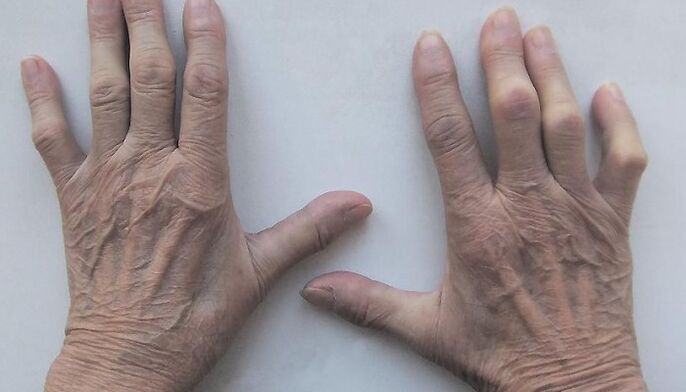
When pain occurs in the hand area, until a certain time we do not pay attention to it;Meanwhile, the development and progression of the disease takes place.What diseases can cause pain in the finger joints?The most common bone joint diseases that can trigger painful attacks:
- Polyosteoarthrosis of bone joints.
- Arthritis (rheumatoid or psoriatic).
- Exacerbation of Gout.
- Tenosynovitis
- Rhysarthrosis.
- Limb injuries.
- Microcirculation disorders.
- Pathology of nerve endings or spinal column.
- Treatment of chronic diseases that do not last long.
Why do my finger joints hurt?Pain in the finger joints in various pathologies has different causes.Let's examine in detail the characteristics of pain in various pathologies.
Osteoarthritis
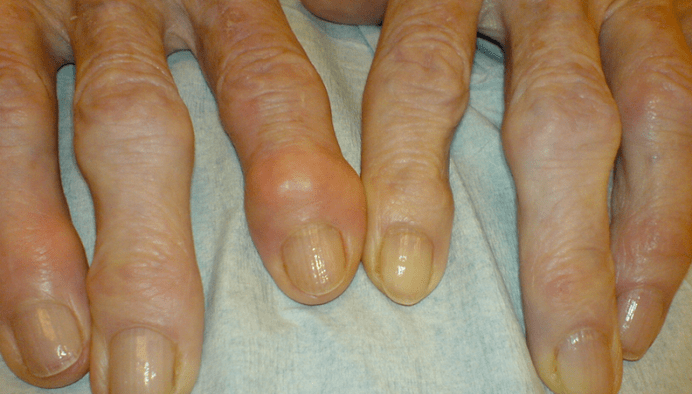
When polyosteoarthrosis occurs, pain in the finger joints can appear among people under the age of 45 and at the age of 55.With this pathology, a distinctive feature is that when the joint is damaged, Heberden's nodes appear.They are located on the back of the palm, which is also characteristic of the fact that they are formed in the same way (on the right and left at the same time in the same location).
Nodules can appear on the phalanges of the fingers (most often the index and middle fingers are affected).It is at the moment of the formation of such a nodule that the patient may feel unpleasant sensations, pain, swelling and redness.First of all, it is necessary to treat the original cause.
Rheumatoid Arthritis
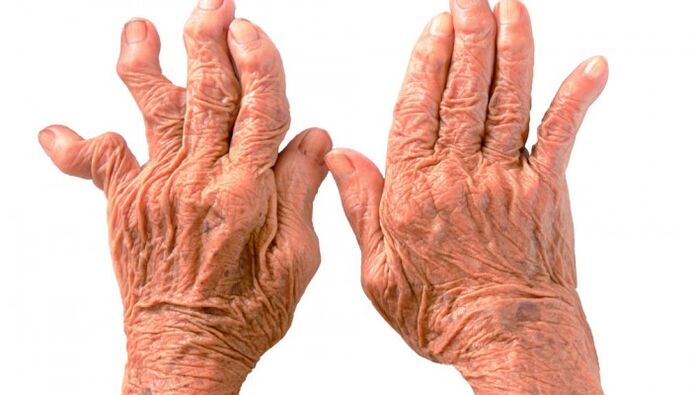
With rheumatoid arthritis, finger joints hurt in 6-7 percent of cases.This disease can occur in people of different age groups, women are more often affected, and is formed against the background of emotional stress, after a cold, infection or hypothermia.The disease begins with inflammatory changes, then the affected joint swells slightly, the pain worsens when flexing the phalanges of the right and left hand.Lesions are usually symmetrical, and other joints, even large ones, may be involved.
This pathology has an inflammatory nature of pain (increasing at night and in the morning, and in the afternoon and evening attacks of pain are slight).In addition to these symptoms, the patient feels a feeling of weakness, has a fever, and may have chills.Therapy should be aimed at treating the underlying disease.
Psoriasis
In 5% of cases, pain may occur due to psoriatic arthritis.People between the ages of 20 and 50 who have skin lesions (psoriatic plaques) are affected.The peculiarity of the inflammatory process is that the disease has axial inflammation (all affected finger joints).The skin over the joint has a burgundy color.
Inflammation can affect the joints of the bones of the right or left hand, but very rarely, which shows its asymmetry.
Gout
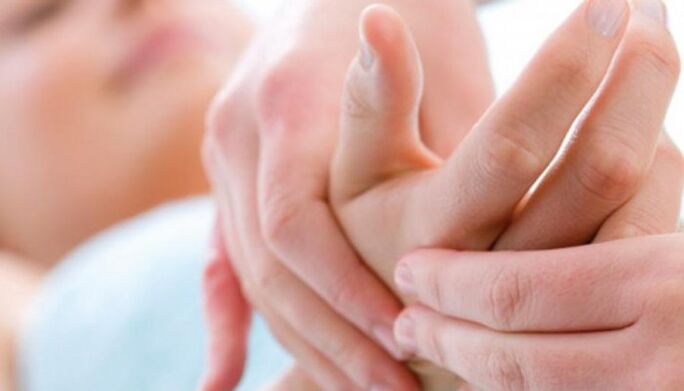
Gout is to blame for pain in less than 4% of cases.It often occurs in men, often it occurs with damage to the big toe, and then affects other joints.Occurs in the age range from 20 to 50 years.In the hand, the disease develops from damage to the thumb (rarely from the little finger), then spreads to other joints, the pain is worse at night, which disturbs the pattern and quality of sleep, the thumb acquires a red color and becomes hot to the touch.
The duration of an acute attack can reach up to 12 days, then the pain decreases.Paroxysmal course of pain syndrome is characteristic of this disease.
Injury
Injuries and dislocations of limbs play an important role when the finger hurts.When cartilage tissue is damaged, gradual regeneration occurs, but will no longer be complete and equal to cartilage;In any case, it will have defects of one degree or another.At first, no symptoms may occur, but gradually the cartilage tissue wears and ceases to function fully, which leads to pain (pain occurs first when the little finger is affected).
Other diseases
De Carvin's tenosynovitis causes pain in 2-3% and involves an inflammatory process in the muscle tissue of the thumb.Usually, the pain occurs at the base of the joint;It is spontaneous or provoked by load, strengthens with flexion and extension (pain does not occur in the area from the index finger to the little finger).
With rhizarthrosis, the thumb on the hand hurts, pathology of its articulation occurs, often it manifests itself in conjunction with polyosteoarthrosis, less often independently.It is provoked by a strong constant load.It is difficult to diagnose the disease from De Carvin's tenosynovitis.But with this pathology, a characteristic feature is the deformation of the finger bones, which is clearly visible on the X-ray of the hand.
Treatment
At the same time, and most importantly, properly prescribed treatment will help avoid pain in the final stages of life.Prevention of rheumatic diseases is an important point in maintaining the same standard of living.But what to do and how to treat this disease if it arises or worsens?
Therapeutic methods should have a comprehensive effect, solve several problems and promote the recovery of damaged tissue.
First of all, it is necessary to correctly diagnose the cause of the disease, then determine the treatment method (medical or surgical).
Drug treatment

The most common group of drugs that can reduce or stop pain are nonsteroidal anti-inflammatory drugs (NSAIDs).In addition to the analgesic effect, they have anti-inflammatory properties.
Medicines can be used independently, taking into account the available instructions.
For arthritis, when the joints of the hands hurt, glucocorticosteroid (GC) drugs are prescribed;This group has an anti-inflammatory effect, which immediately stops the pain attack.To enhance the healing and regenerative effect, various oils and creams are used;They will also help relieve pain in a short time.
Physiotherapy methods of treatment and prevention are widespread.The most popular methods are:
- Phonophoresis.
- Ultra-High Frequency (UHF) Therapy.
- Ultraviolet and infrared radiation.
- Do gymnastics.
- Therapeutic and restorative massage.
- Moderate physical activity.
Surgical treatment
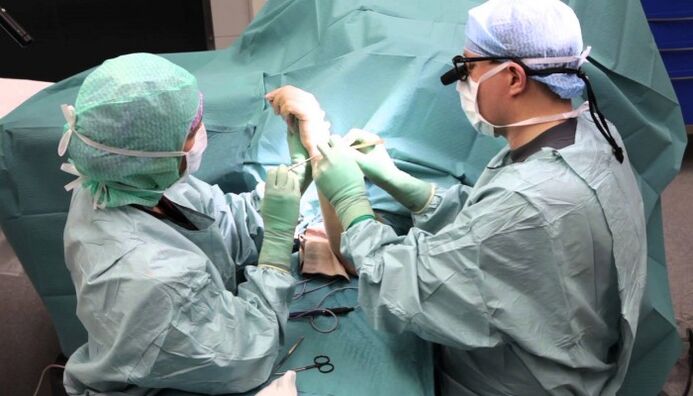
This method is radical and is used already in the final and advanced stages of the disease.Surgery is performed using a prosthesis, replacing the articular surface or restoring blood flow.































